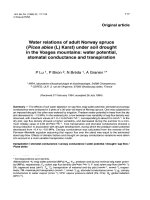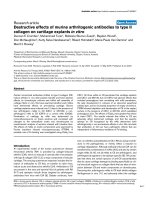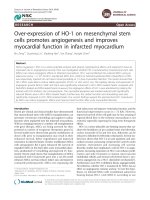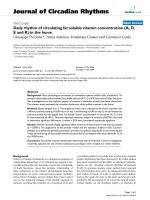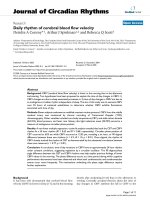Báo cáo y học: "Daily rhythm of circulating fat soluble vitamin concentration (A, D, E and K) in the horse" pdf
Bạn đang xem bản rút gọn của tài liệu. Xem và tải ngay bản đầy đủ của tài liệu tại đây (299.91 KB, 4 trang )
BioMed Central
Page 1 of 4
(page number not for citation purposes)
Journal of Circadian Rhythms
Open Access
Short paper
Daily rhythm of circulating fat soluble vitamin concentration (A, D,
E and K) in the horse
Giuseppe Piccione*, Anna Assenza, Fortunata Grasso and Giovanni Caola
Address: Dipartimento di Morfologia, Biochimica, Fisiologia e Produzioni Animali – Facoltà di Medicina Veterinaria – Sezione di Fisiologia
Veterinaria – Università degli Studi di Messina – Polo Universitario dell'Annunziata – 98168 Messina – Italy
Email: Giuseppe Piccione* - ; Anna Assenza - ; Fortunata Grasso - ;
Giovanni Caola -
* Corresponding author
Abstract
Background: Many physiological processes of mammalian species exhibit daily rhythmicity. An
intrinsic relationship exists between fat soluble vitamins (A, D, E and K) and several body functions.
Few investigations on the rhythmic pattern of vitamins in domestic animals have been carried out.
The present study evaluated the circadian rhythmicity of fat soluble vitamins in the horse.
Methods: Blood samples from 5 Thoroughbred mares were collected at four-hour intervals over
a 48-hour period (starting at 8:00 hours on day 1 and finishing at 4:00 on day 2) via an intravenous
cannula inserted into the jugular vein. Fat soluble vitamin concentration in the serum (A, D, E and
K) was measured by HPLC. One-way repeated measures analysis of variance (ANOVA) was used
to determine significant differences. p values < 0.05 were considered statistically significant.
Results: ANOVA showed a highly significant effect of time in all the horses for the vitamins studied
(p < 0.0001). The application of the periodic model and the statistical analysis of the "Cosinor"
enabled us to define the periodic parameters and their acrophases (expressed in hours) during the
2 days of monitoring: all the studied vitamins showed diurnal acrophases with values between 15:16
and 18:08 hours.
Conclusion: Fat soluble vitamins exhibit daily rhythmicity with diurnal peak. Further investigations
could help optimize the use of these substances according to their circadian (or other) rhythms.
Background
Daily or circadian rhythmicity is a ubiquitous property of
mammalian physiology [1,2]. Vitamins are organic com-
pounds required in trace amounts to promote a multitude
of body functions. Given the intrinsic relationship of
these substances to the relative physiological processes
(mechanisms of vision, mineral homeostasis, oxidative
stress, blood clotting), several studies have been carried
out on the temporal changes of fat soluble vitamins in
humans, revealing the existence of a circannual [3,4] and
a circadian pattern [5,6], while also in laboratory animals
a daily rhythmicity has been observed [7,8]. Other studies
have been conducted on the effect of vitamin D adminis-
tration on the circadian mineral rhythms of humans
[9,10]. In previous studies, some authors have reported
the concentration-time curve, by taking serial blood sam-
ples within 24 hours, in order to calculate some indices,
such as the peak, the time to the peak and the area sub-
tended by the increments [11]. Given the lack of experi-
mental studies on the rhythmic pattern of vitamins in
Published: 15 July 2004
Journal of Circadian Rhythms 2004, 2:3 doi:10.1186/1740-3391-2-3
Received: 13 May 2004
Accepted: 15 July 2004
This article is available from: />© 2004 Piccione et al; licensee BioMed Central Ltd. This is an Open Access article: verbatim copying and redistribution of this article are permitted in all
media for any purpose, provided this notice is preserved along with the article's original URL.
Journal of Circadian Rhythms 2004, 2:3 />Page 2 of 4
(page number not for citation purposes)
domestic animals based on organism's physiological sta-
tus, we investigated the existence of circadian rhythmicity
of fat soluble vitamins (A, D, E and K) in the horse.
Methods
The subjects were 5 Thoroughbred mares, 8 years old.
They were housed in individual stalls under a natural
spring photoperiod (sunrise at 06:06, sunset at 18:49)
and natural indoor temperature (19–21°C). Food (hay
and concentrate) was provided three times daily, with
water ad libitum. The study was carried out in April. Blood
samples were collected at four-hour intervals over a 48-
hour period (starting at 8:00 hours on day 1 and finishing
at 4:00 on day 2) via an intravenous cannula inserted into
the jugular vein. Blood samples were transferred into
Vacutainer tubes containing no additive. The tubes were
clotted at room temperature for 1 hour and subsequently
centrifuged at 2500 g for 10 min. The resulting serum was
stored at -80°C until analysis. Serum vitamin concentra-
tion (A, D, E and K) was measured by high performance
liquid chromatography (HPLC), using fluorimetric detec-
tion for A and K and UV spectrophotometry for D and E
vitamins. All the results were expressed as mean ± SD.
One-way repeated measures analysis of variance
(ANOVA) was used to determine significant differences. p
values < 0.05 were considered statistically significant.
Data were analyzed using the software STATISTICA 5.5
(StatSoft Inc., USA). For each measurement we applied a
trigonometric statistical model to the average values of
each time series, so as to describe the periodic phenome-
non analitically, by individuating the main characteristic
parameters: Mesor (Midline Estimating Statistic of
Rhythm), expressed in the same conventional unit of the
relative parameter, with the confidence interval (C.I.) at
95%, Amplitude (A), expressed in the same unit as the rel-
ative Mesor, and Acrophase (φ), obtained with the single
Cosinor method [12] and expressed in hours, with the C.I.
at 95%.
Results and discussion
The results obtained during the experimental period indi-
cate the existence of a daily rhythm of circulating fat solu-
ble vitamin concentration in the horse, as shown in Figure
1. ANOVA showed a highly significant effect of time in all
the horses for the vitamins studied, as follows: vitamin A,
F
(11,44)
= 22.89, p < 0.0001; vitamin D
2
, F
(11,44)
= 68.07, p
< 0.0001; vitamin E, F
(11,44)
= 11.50, p < 0.0001; vitamin
K, F
(11,44)
= 12.27, p < 0.0001. The application of the peri-
odic model and the statistical analysis of the "Cosinor"
enabled us to define the periodic parameters and their
acrophases (expressed in hours) during the 2 days of
monitoring. All the vitamins studied showed diurnal acro-
phases, as follows: vitamin A, at 15:20 both for the 1
st
and
the 2
nd
day; vitamin D
2
, at 14:16 (1
st
day) and at 15:12
(2
nd
day); vitamin E, at 15:48 (1
st
day) and at 16:00 (2
nd
day); vitamin K, at 17:00 (1
st
day) and at 18:08 (2
nd
day).
It seems reasonable to hypothesise that the presence of
rhythmic diurnal variations in the activity of vitamins
could be linked to some physiological or clinical events of
the organism. Little is known about the temporal variabil-
ity in serum vitamin concentration and its probable rela-
tionship to the biological processes, despite the important
role of these substances in maintaining the body's physi-
ological status.
Conclusion
It is concluded that a daily rhythmicity exists in serum
concentration of vitamins A, D, E and K in the horse, with
diurnal acrophases. The observation of acrophases
included between 15:16 and 18:08 during the experimen-
tal period for all the vitamins studied could suggest the
existence of exogenous and/or endogenous synchroniz-
ers, as observed for other hematochemical parameters.
Further studies involving experimental manipulation of
feeding time and ration quality can produce the necessary
knowledge for the optimization of the use of these sub-
stances according to their temporal pattern. Our research
could be useful for its clinical implications, for example,
in the choosing of the time of day at which vitamin
administration reveals its greatest effect.
Authors' contributions
GP-Designed the study and evaluated the data statistically
AA-Carried out the data collection procedures
FG-Carried out the data collection procedures
GC-Supervised the data collection procedures and con-
ducted bibliographic research.
All authors read and approved the final manuscript.
Journal of Circadian Rhythms 2004, 2:3 />Page 3 of 4
(page number not for citation purposes)
Daily rhythm of serum fat soluble vitamin concentration in the horseFigure 1
Daily rhythm of serum fat soluble vitamin concentration in the horse. Each point represents mean ± SD. Φ indicates
the acrophases. Black and white bars at the bottom of the figure indicate the duration of the dark and light phases of the natu-
ral light-dark cycle.
Publish with BioMed Central and every
scientist can read your work free of charge
"BioMed Central will be the most significant development for
disseminating the results of biomedical research in our lifetime."
Sir Paul Nurse, Cancer Research UK
Your research papers will be:
available free of charge to the entire biomedical community
peer reviewed and published immediately upon acceptance
cited in PubMed and archived on PubMed Central
yours — you keep the copyright
Submit your manuscript here:
/>BioMedcentral
Journal of Circadian Rhythms 2004, 2:3 />Page 4 of 4
(page number not for citation purposes)
References
1. Refinetti R: Circadian Physiology. CRC Press, Boca Raton, FL;
2000.
2. Takahashi JS, Turek FW, Moore RY: Circadian Clocks. New York,
Kluwer/Plenum; 2001.
3. Coen G, Bianchini G, Mazzaferro S, Bianchi AR, Gallucci G: Circan-
nual rhythm of plasma 25-hydroxycholecalciferol in normal
man. Boll Soc Ital Biol Sper 1980, 56:1535-1540.
4. Woitge HW, Knothe A, Witte K, Schmidt-Gayk H, Ziegler R, Lem-
mer B, Seibel MJ: Circannual rhythms and interactions of vita-
min D metabolites, parathyroid hormone, and biochemical
markers of skeletal homeostasis: a prospective study. J Bone
Miner Res 2000, 15:2443-2450.
5. Kamali F, Edwards C, Wood P, Wynne HA, Kesteven P: Temporal
variations in plasma vitamin K and lipid concentrations and
clotting factor activity in humans. Am J Hematol 2001,
68:159-163.
6. Singh RB, Niaz MA, Cornelissen G, Otsuka K, Siegelová J, Fišer B, Hal-
berg F: Circadian rhythmicity of circulating vitamin
concentrations. Scripta Medica 2001, 74:93-96.
7. Soulban G, Labrecque G, Belanger PM: Temporal variation in the
effects of warfarin on the vitamin K cycle. Chronobiol Int 1990,
7:403-411.
8. Lapenna D, De Gioia S, Mezzetti A, Porreca E, Ciofani G, Marzio L,
Capani F, Di Ilio C, Cuccurullo F: Circadian variations in antioxi-
dant defences and lipid peroxidation in the rat heart. Free
Radic Res Commun 1992, 17:187-194.
9. Markowitz ME, Rosen JF, Mizruchi M: Effects of 1,25 dihydroxyvi-
tamin D
3
administration on circadian mineral rhythms in
humans. Calcif Tissue Int 1985, 37:351-356.
10. Markowitz ME, Gundberg CM, Rosen JF: The circadian rhythm of
serum osteocalcin concentrations: Effects of 1,25 dihydroxy-
vitamin D administration. Calcif Tissue Int 1987, 40:179-183.
11. Kronfeld D: Clinical assessment of nutritional status of the
horse. In Metabolic and Endocrine Problems of the Horse Edited by:
Watson T. London: WB Saunders; 1998:185-215.
12. Nelson W, Tong YL, Lee JK, Halberg F: Methods for cosinor-
rhythmometry. Chronobiologia 1979, 6:305-23.


